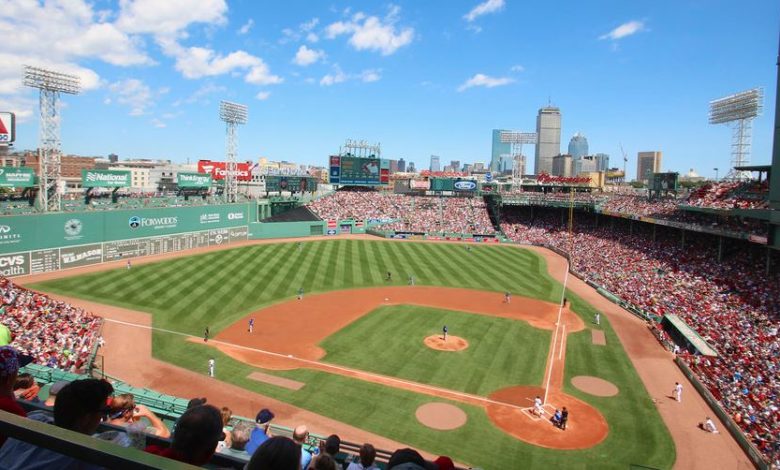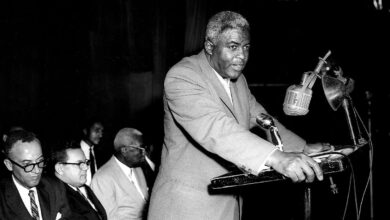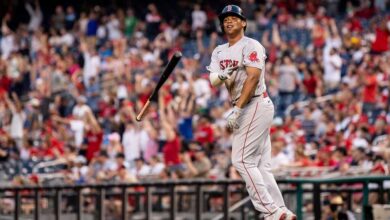
Fenway Park is a Major League baseball stadium in Boston, Massachusetts. It was opened in 1912 which makes it 107 years old, and it has been home to the Boston Red Sox all along. It is the oldest park in the MLB, and it has been renovated and expanded multiple times in the area around Kenmore Square. Believe it or not, Fenway Park is the fourth-smallest Major League Baseball ballpark by seating, and second smallest by its total capacity which is about thirty-seven thousand. Fenway is only one of eight stadiums that cannot hold a capacity of at least forty thousand, one of the others is PNC Park in Pittsburgh. Today Fenway Park, is known as one of the most familiar and interesting venues in the world.
Fenway History
The history of Fenway Park and its name, began in 1911 when John I. Taylor moved the Red Sox to the new Fenway from the old Huntington Avenue Grounds. He bought the ground by Brooklane Avenue, Jersey Street, Lansdowne Street, and Van Ness Street and made it into a larger baseball stadium. He claims Fenway Park got its name from the ballpark’s location in the Fenway neighborhood in Boston.
The neighborhood’s name came from the fact that it was built by filling in the “fens” which was another name for the marshes in the area. This filled over the area called the Back Bay Fens urban park in the nineteenth century. Adding on to that, John’s family owned the ‘Fenway Realty Company’ which is another possible way Fenway Park might have got its name.
The first game ever played in Fenway Park was on April 20th, 1912, the Boston Red Sox played against the New York Highlanders. The first pitch was thrown by Boston’s Mayor John F. Fitzgerald. Boston won the exciting game seven to six. It went to the 11th inning. It was a very big deal but because of the Titanic sinking on April 15th, 1912, the coverage of the game was not a priority since the tragedy happened a few days earlier. One of the most memorable and historic events that Fenway held, was in June 1919 for Irish Independence.
The turnout was said to be around fifty thousand people which was the largest crowd ever to attend Fenway. In 1944, Franklin Delano Roosevelt gave his last campaign speech before the presidential election. Even with all the history, Fenway Park up until 1965 was known to have very low attendance, even having two games with less than five hundred people in the crowd. That changed during the 1967 “The Impossible Dream” season when the Red Sox finished the season with ninety-two wins and seventy losses. It was the team’s first winning season since 1958, and after beating the Detroit Tigers and Minnesota Twins by one game, the Red Sox shocked the world and made it to the World Series. That was the team’s first appearance since 1946, but the team ended up losing to the Cardinals in seven games.
After that season, turnouts for the following years grew tremendously! During the 2008 Red Sox season, Fenway Park broke the Major League record for most consecutive sold-out ball games which is four hundred fifty-six in a row. In 2009, Fenway Park celebrated five hundred consecutive sellout games keeping the streak alive. The Red Sox was the first baseball team to achieve five hundred consecutive sellouts along with three other NBA (National Basketball Association) teams. The sellout streak ended in 2013 with seven hundred ninety-four regular-season games, and twenty-six postseason games, for an honestly mind-blowing total of eight hundred twenty.
Fenway’s Famous Features
Over the years, Fenway had a bunch of changes and additions. There are a few well-known renovations and notable features such as The Triangle. It is the deepest part of the field at four hundred twenty feet, where the walls form a triangle. It makes the field an unusual shape. Pesky’s Pole is another, which is identified at the right field foul pole. It was dedicated to Johnny Pesky “Mr. Red Sox”, who passed away in 2012.
The Green Monster, the left-field wall was built in 1934 and sits at thirty-seven feet high. Before the wall, it was just a slope of dirt. The wall was blue until in 1947 the wall was painted over forest green, giving the wall its nickname, The Green Monster. Fenway’s manual scoreboard is also famous because it is one of the last ones in use today. During games, three workers are needed to keep up with operating the scoreboard.
Last but not least, The Lone Red Chair, is located in the right field. It symbolizes Ted Williams’ longest home run and longest home run hit at Fenway Park. In 1946, it was measured at five hundred and two feet. The ball ended up hitting a fan in the head whose name was Joseph A. Boucher he ended up not being hurt. He was later quoted and said “how far away must one sit to be safe in the park?”, later adding it was so sunny that day and hard to see that the only thing the fans could do to be missed by a ball is duck and hope!
The longest home run record at Fenway Park was almost broken in 2001. On June 23rd, Manny Ramirez hit a home run over the Green Monster, hitting the light post. If the ball didn’t hit the light post it would have cleared the park, and the estimate was about five hundred and one feet. It still would have been one foot shorter than Williams’ home run.
Fenway’s Many Uses
Fenway Park is used for many different events, which keeps the stadium active all year long, from concerts to different types of sporting events. We all know Fenway is home to the Red Sox, but back in 1914 to 1915, the crosstown rivals the Boston Braves held games at Fenway until Braves Field was built.
Around that time boxing was a huge part of our culture and Fenway was home to some of boxing’s main events from the years 1920 to 1956. On October 9th, 1920 Fenway hosted the first outdoor boxing event in Boston, which was very exciting since it was a different atmosphere. The last and most recent boxing event was on June 16th, 1956 featuring four fights. It may be little known but Fenway Park has a history of hosting soccer matches. When the Boston Soccer Club wasn’t traveling they played matches at Fenway from the years 1925 to 1929.
Recently, Liverpool of the English Premier League, which is owned by Fenway Sports Group, has hosted matches at Fenway calling it “Football at Fenway” since 2010. Fenway is home to American football also! The earliest use of the ballpark for football was Boston College in 1916, and certain games are played there until this day. From the years 1933 to 1936, the Boston Redskins who were in the National Football League at the time played at Fenway for four seasons. At the beginning of 2020, Fenway will be hosting “The Fenway Bowl”. This will be a college bowl game for a team in the Atlantic Coast Conference and a team from the American Athletic Conference.
Fenway Park is also famous for concerts they hosted, for the first time in 1973 bringing in legends like Stevie Wonder and Ray Charles then no concerts until 2003. It is unclear why they waited thirty years but they came back to great popularity having at least one concert a year. Lastly, one of the most surprising events Fenway has held was the Polartec Big Air at Fenway which is a ski and snowboarding event in February of 2016. The big air jump was one hundred forty feet high, towering above the lights.
Fenway Forever
Fenway Park has had a long and interesting history being the oldest baseball field in the United States. It is preserving important history by doing things like keeping the manual scoreboard and keeping the wooden seats in the grandstand which are the last wooden seats in all of the major stadiums. The ballpark also kept up with the times by being the first field to have netting behind home plate for foul balls to prevent injuries to the fans. Joseph A. Boucher would have probably liked that idea!




